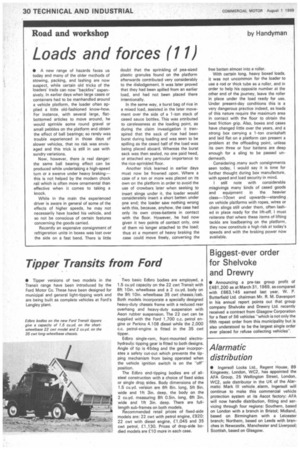Road and workshop
Page 32

If you've noticed an error in this article please click here to report it so we can fix it.
Loads and forces (11)
• A new range of hazards faces us today and many of the older methods of stowing, packing, and lashing are now suspect, while certain old tricks of the loaders trade can now "backfire" expensively. In earlier days when large cases or containers had to be manhandled around a vehicle platform, the loader often applied a little old-fashioned know-how. For instance, with several large, flatbottomed articles to move around, he would sprinkle some round gravel or small pebbles on the platform and obtain the effect of ball bearings; so rarely was trouble experienced in those days of slower vehicles, that no risk was envisaged and this trick is still in use with sundry variations.
Now, however, there is real danger: the same ball bearing effect can be produced while undertaking a high-speed turn or a swerve under heavy braking— this is not helped by the modern chock rail which is often more ornamental than effective when it comes to taking a knock.
While in the main the experienced driver is aware in general of some of the effects of higher speeds, he may not necessarily have loaded his vehicle, and so not be conscious of certain features concerning the goods carried.
Recently an expensive consignment of refrigeration units in boxes was lost over the side on a fast bend. There is little doubt that the sprinkling of pea-sized plastic granules found on the platform afterwards contributed very considerably to the dislodgement. It was later proved that they had been spilled from an earlier load, and had not been placed there intentionally.
In the same way, a burst bag of rice in a mixed load, assisted in the later movement over the side of a 1-ton stack of cased sauce bottles. This was attributed to carelessness at the loading point, as during the claim investigation it transpired that the sack of rice had been burst during loading and was seen to be spilling as the cased half of the load was being placed aboard. Whereas the burst sack was then sealed, no one paid heed, or attached any particular importance to the rice-sprinkled floor.
Another trick learned in earlier days must now be frowned upon. Where a case of a ton or more was placed on its own on the platform in order to avoid the use of crowbars later when seeking to insert slings under it, the loader would considerately insert a short batten under one end; the loader saw nothing wrong with this, because, anyhow, the case had only its own cross-battens in contact with the floor. However, he had now given it two points of contact only, one of them no longer attached to the load; thus at a moment of heavy braking the case could move freely, converting the free batten almost into a roller.
With certain long, heavy boxed loads, it was not uncommon for the loader to use a rod or thick tube as a roller, and in order to help his opposite number at the other end of the journey, leave the roller in place under the load ready for use. Under present-day conditions this is a very dangerous practice indeed, as loads of this nature require the maximum area in contact with the floor to obtain the best friction grip. Also, boxes and cases have changed little over the years, and a strong box carrying a 1-ton crankshaft and laid flat on a platform can present a problem at the offloading point, unless its own three or four battens are deep enough for a sling to be passed underneath.
Considering .many such consignments seen today, I would say it is time for further thought during box manufacture, with speed and load security in mind.
I still note with considerable misgivings many kinds of cased goods and equipment in the heavier class 10cwt and upwards—standing on vehicle platforms with ropes, wires or chain slings still under them, often lashed in place ready for the lift-off. I must reiterate that where these items of lifting tackle are loadbearing on the platform, they now constitute a high risk at today's speeds and with the braking power now available.


































































































